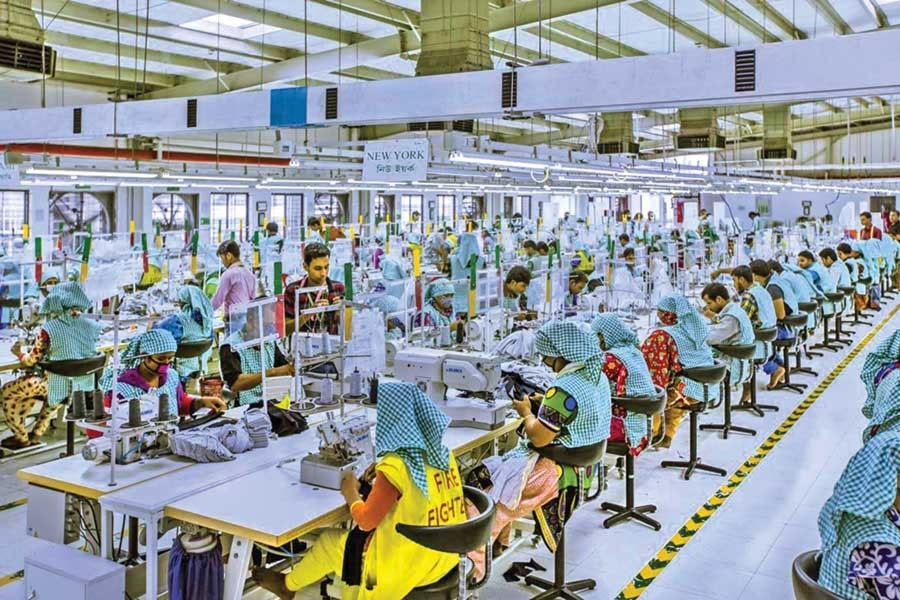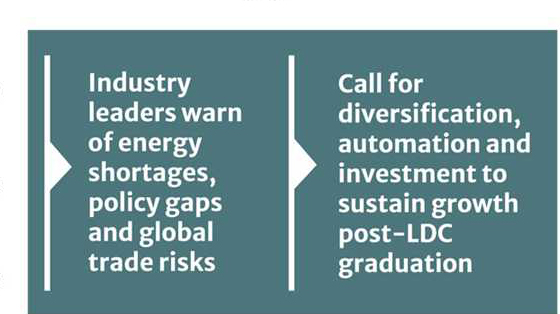
Published :
Updated :

Bangladesh's readymade garment (RMG) sector must urgently diversify its product mix, moving from low-end to high-value items, to strengthen export resilience and navigate post-LDC graduation challenges amid shifting global trade dynamics, industry leaders said on Thursday.
At a breakfast meeting, they identified energy shortages, particularly affecting gas-dependent backward linkage industries, as a major threat to RMG growth.
They also stressed the need for infrastructure expansion, policy coherence, automation, green manufacturing and skills development.
Concerns over high costs, tight liquidity and weak risk governance were also raised, with calls for stronger collaboration and actionable roadmaps to enhance productivity, attract investment and drive sustainable growth beyond the current RMG model.
The meeting, themed "Bangladesh's RMG Sector: The Way Forward," was organised by the American Chamber of Commerce in Bangladesh (AmCham) at a city hotel.
It was attended by Bangladesh Investment Development Authority Director General (Investment Ecosystem) Gazi AKM Fazlul Haque, National Board of Revenue (NBR) First Secretary (Customs Export and Bond) Mohammad Naziur Rahman Miah, US Embassy Commercial Counsellor Paul Frost and Labour Attaché Leena Khan, among others.

Bangladesh Garment Manufacturers and Exporters Association (BGMEA) President Mahmud Hasan Khan highlighted the severity of the energy crisis, noting that with only two Floating Storage and Regasification Units (FSRUs) in operation, gas supply constraints are hampering industry growth.
He criticised the abrupt cancellation of 54 letters of intent for solar energy projects by the previous government, urging renegotiations to restore investor confidence, while welcoming the Merchant Power Purchase Agreement for solar power despite challenges such as land scarcity.
Mr Khan warned that many mid- and low-tier factories are struggling without basic productivity metrics, leading to closures and unrest. Of BGMEA's 7,100 members, fewer than 3,000 are still exporting, prompting the association to step up efforts to boost efficiency and resilience.
Bangladesh Competition Commission Chairman AHM Ahsan underscored the need for vertical diversification within the RMG sector to move up the value chain.
Citing the US tariff hike and the impending LDC graduation, he called the current situation a wake-up call for improving productivity and competitiveness to withstand trade pressures.
Export Promotion Bureau Vice Chairman Md Anwar Hossain highlighted policy reforms, including a proposed bank-backed bond facility for partial exporters to enable duty-free imports with bank guarantees.
He said strengthened US-Bangladesh ties could open new export markets, and announced the formation of a "$100 Billion RMG Export Cell" to coordinate on energy, banking and taxation issues with BGMEA, BKMEA and others.
With diversification and stronger collaboration, he believes Bangladesh could achieve US$100 billion in RMG exports by FY2027-28, he added.
In his opening remarks, AmCham President Syed Ershad Ahmed noted that garments account for 81.5 per cent of Bangladesh's exports and 11 per cent of GDP, with the EU and US taking 40 per cent and 17.6 per cent respectively.
This leaves the economy more exposed to global trade shifts than competitors such as India and Vietnam, he added.
Citing assessments by the Asian Development Bank (ADB) and World Bank, Mr Ahmed warned that US tariff hikes could cut GDP growth by 1.0-2.0 percentage points, while trade uncertainty and protectionism threaten investment and financial stability.
A 1.0-per cent tariff rise could reduce global trade by 0.5-1.0 per cent, he said, stressing the need for diversification and proactive policies to build long-term resilience, he added.
Munni_fe@yahoo.com


 For all latest news, follow The Financial Express Google News channel.
For all latest news, follow The Financial Express Google News channel.